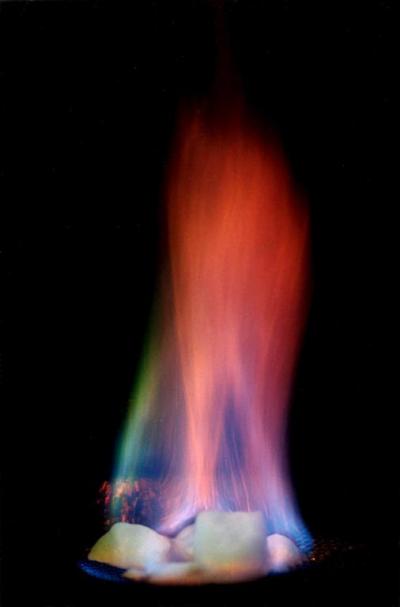Gas hydrates, known as "ice that burns," hold special promise for helping to combat global warming by leaving a smaller carbon dioxide footprint than other fossil fuels.
The icy chunks could supplement traditional energy sources that are in short supply and which produce large amounts of carbon dioxide linked to global warming, the scientists say.
Last November, a team of U.S. Geological Survey (USGS) researchers announced a giant step toward that bridge to the future. In a landmark study, the USGS scientists estimated that 85.4 trillion cubic feet of natural gas could potentially be extracted from gas hydrates in Alaska's North Slope region, enough to heat more than 100 million average homes for more than a decade.

Gas hydrates, the "ice that burns." Credit: J. Pinkston and
L. Stern/US Geological Survey
"These gas hydrates could serve as a bridge to our energy future until cleaner fuel sources, such as hydrogen and solar energy, are more fully realized," says study co-leader Tim Collett, Ph.D., a research geologist with the USGS in Denver, Colo. "It's definitely a vast storehouse of energy, but it is still unknown how much of this volume can actually be produced on an industrial scale."
That volume, he says, depends on the ability of scientists to extract useful methane, the main ingredient in natural gas, from gas hydrate formations in an efficient and cost-effective manner. Scientists worldwide are now doing research on gas hydrates in order to understand how this strange material forms and how it might be used to supplement coal, oil, and traditional natural gas.
Although scientists have known about gas hydrates for decades, they've only recently begun to try to use them as an alternative energy source. Gas hydrates, also known as "clathrates," form when methane gas from the decomposition of organic material comes into contact with water at low temperatures and high pressures. Those cold, high-pressure conditions exist deep below the oceans and underground on land in certain parts of the world, including the ocean floor and permafrost areas of the Arctic.
Today, researchers are finding tremendous stores of gas hydrates throughout the world, including United States, India, and Japan. In addition to Alaska, the United States has vast gas hydrate deposits in the Gulf of Mexico and off its eastern coast. Interest in and support of hydrate research is now growing worldwide. Japan and India currently have among the largest, most well-funded hydrate research programs in the world.
"Once we have learned better how to find the most promising gas hydrate deposits, we will need to know how to produce it in a safe and commercially-viable way," says study co-author Ray Boswell, Ph.D. He manages the National Methane Hydrate R&D Program of the U.S. Department of Energy's National Energy Technology Laboratory in Morgantown, W. Va. "Chemistry will be a big part of understanding just how the hydrates will respond to various production methods."
One of the more promising techniques for extracting methane from hydrates involves simply depressurizing the deposits, Boswell says. Another method involves exchanging the methane molecules in the "clathrate" structure with carbon dioxide. Workers can, in theory, collect the gas using the same drilling technology used for conventional oil and gas drilling.
Under the Methane Hydrate Research and Development Act of 2000, the U.S. government has already spent several million dollars, in collaboration with universities and private companies, to investigate gas hydrates as an alternative energy source. Scientists are particularly optimistic about the vast stores of gas hydrates located in Alaska and in the Gulf of Mexico. Research is also accelerating under the U.S. Department of Energy and USGS to better understand gas hydrate's role in the natural environment and in climate change.
"Gas hydrates are totally doable," Collett says. "But when and where we will see them depends on need, motivation, and our supply of other energy resources. In the next five to ten years, the research potential of gas hydrates will be more fully realized."
Other highlights in the "Gas Hydrates and Clathrates" symposium included:
Expert provides overview of gas hydrates for energy production, climate change — Scientists predict that natural gas hydrates will play a major role in both energy and climate change in the future. E. Dendy Sloan, Ph.D., of the Colorado School of Mines, will provide an overview of this rapidly evolving field. He is the author over 200 publications, including the third edition of "Clathrate Hydrates of Natural Gases," (2008), co-authored by Carolyn Koh. (FUEL 041, Monday, March 23, 8:05 a.m., at the Hilton, Grand Ballroom A, during the symposium "Gas Hydrates and Clathrates.")
Japan's promising national gas hydrate program – Japan has one of the world's largest gas hydrate research programs and is well on its way toward using these hydrates as an important fuel source. Masanori Kurihara, Ph.D., of Japan Oil Engineering Co., Ltd., will describe Japan's National Methane Hydrate Exploitation Program, including research on promising methane hydrate deposits in the Eastern Nankai Trough of offshore Japan. (FUEL 042, Monday, March 23, 8:45 a.m., at the Hilton, Grand Ballroom A, during the symposium, "Gas Hydrates and Clathrates.")
Overview of gas hydrate research in Canada — Canada has been involved in gas hydrates research since the 1970s and now plays a leading role in hydrate production technology. Scott R. Dallimore, of Geological Survey of Canada, will provide an overview of the country's contributions toward gas hydrate production. (FUEL 045, Monday, March 23, 11:05 a.m., at the Hilton, Grand Ballroom A, during the symposium, "Gas Hydrates and Clathrates.")





Comments